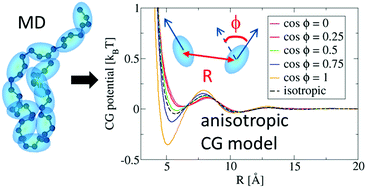Assessment of an anisotropic coarse-grained model for cis-1,4-polybutadiene: a bottom-up approach†
Abstract
The spherical representation usually utilized for the coarse-grained particles of soft matter systems is an assumption and pertinent studies have shown that both structural and dynamical properties can depend on anisotropic effects. On these grounds, we develop coarse-grained equations of motion which take into account explicitly the anisotropy of the beads. As a first step, this model incorporates only conservative terms. Inclusion of the dissipative and random terms is in principle possible but is beyond the scope of this study. The translational dynamics of the beads is tracked using the position and momentum of their center of mass, while their rotational dynamics is modeled by representing their orientation through the use of quaternions, similarly to the case of rigid bodies. The associated force and torque controlling the motion are derived from atomistic molecular dynamics (MD) simulations via a bottom-up approach and define a coarse-grained potential. The assumptions of the model are clearly stated and checked for a reference system of a cis-1,4-polybutadiene melt. In particular, the choice of the angular velocity as a slow variable is justified by comparing its dynamics to atomic vibrations. The accuracy of this approach to reproduce static structural features of the polymer melt is assessed.



 Please wait while we load your content...
Please wait while we load your content...